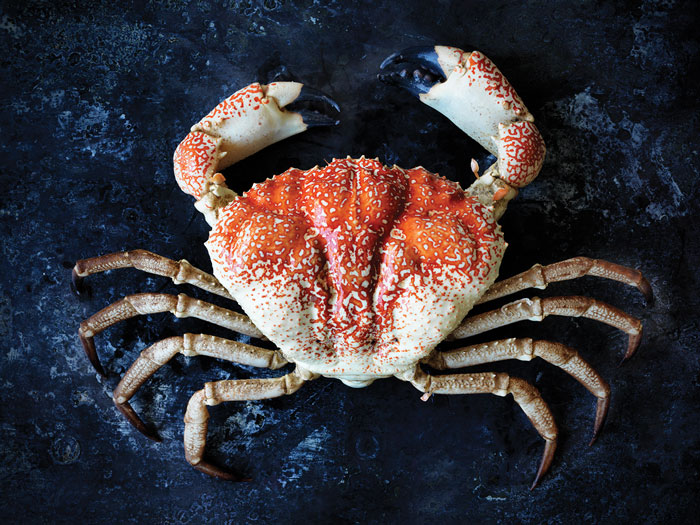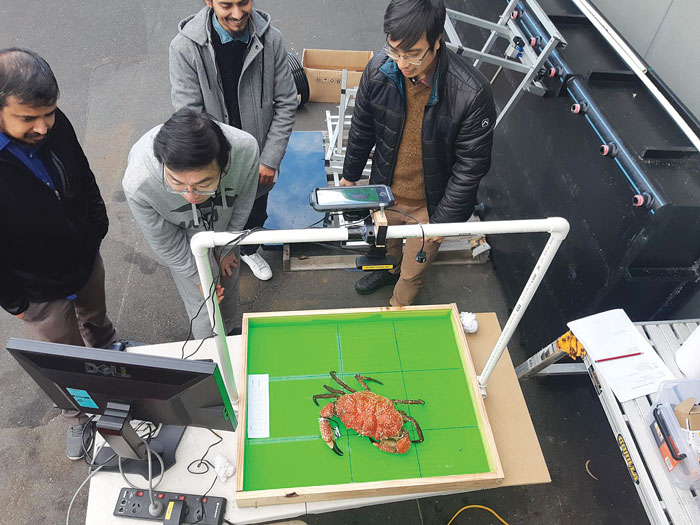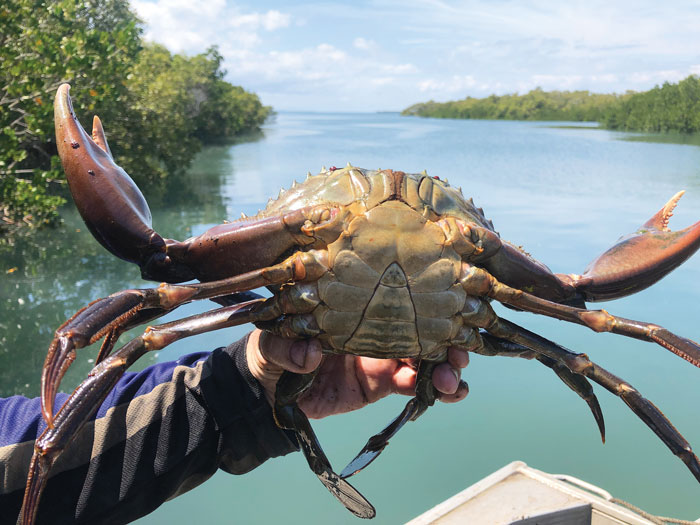Diverse approaches are being trialled to gather more data about two of Australia’s giant crab fisheries, reflecting the differences in the species and the way they are fished
By Corrina Ridgway
Deep on the continental shelf line in the cold waters off southern Australia, brilliantly patterned giants of the crustacean kingdom wander.
These enigmatic goliaths are Pseudocarcinus gigas, or the Giant Crab, and they form part of commercial fisheries across Tasmania, Victoria, South Australia and southern Western Australia.
Oceans away, in the warm, shallow waters along the mangrove coasts and gulfs of the Northern Territory, Queensland and New South Wales, another giant swims: Scylla serrata, the Giant Mud Crab.
Both are high-value species that form part of state fisheries and they have potential for stable, sustainable futures. But there is a frustrating lack of data about them, and two new FRDC-funded projects were launched last year to address the gaps.
There are significant differences between the species, their life cycles, the size of the fisheries and how fishers operate. These differences are reflected in the approaches researchers are using in their quest for better data, which will be used to improve stock assessments and inform catch limits in the respective fisheries.
A key consideration is to create data-collection processes that are both economical and practical. Collaborations with fishers are critical to both projects.

Deepwater giants
Giant Crabs are currently seen as a single population across southern Australia, and they are caught in traps and pots along the continental shelf in depths of about 200 metres. Slow growing, they live for more than 30 years, can weigh over 10 kilograms, and take four to seven years to reach legal size.
All state fisheries have limited entry and are managed by quota, and by spatial and temporal closures. From 2010 to 2019, the annual catch ranged between 43 and 89 tonnes, with the largest volumes harvested from Tasmania.
At the Victorian Fisheries Authority (VFA), Fishery Manager Toby Jeavons is leading the multi-jurisdictional project to fill knowledge gaps in Giant Crab population data.
He says crab size frequency is critical data for current stock assessment models. But the remote, deepwater habitat of the species and the boutique nature of the fisheries make getting enough data difficult.
The data that are available are also “highly volatile” as a result of equally variable fishing efforts. The limited data, and their volatility, make it challenging to detect changes in the stock levels. The 2020 Status of Australian Fish Stocks (SAFS) Reports (fish.gov.au) identifies the species as sustainable in South Australia, Victoria and Western Australia, but depleted in Tasmania.
The FRDC Giant Crab project is co-funded by a University of Tasmania (UTAS) College of Sciences and Engineering incentive grant. It is trialling an innovative tech-driven approach using software and onboard cameras to gather data needed to improve the accuracy of stock assessments.
The project team includes the UTAS Institute for Marine and Antarctic Studies (IMAS) and its School of Information and Communication Technology, the South Australian Research and Development Institute (SARDI) and the VFA. Giant Crab fishers will work with researchers to trial new technology to capture carapace images onboard their vessels once the project advances beyond land-based trials.

Carapace images
To take carapace images, crabs are placed on a pressure- sensitive pad marked with a grid to record size. Initially, the crab’s weight will trigger image capture, but there are plans to head towards auto-detection.
The customised software program being developed then automatically analyses the image taken, recording the crab’s carapace length, sex and a ‘unique ID’. This ID will use images of the crab’s mottled carapace as a ‘fingerprint’, which will be collated in a central database. The recapture and re-recording of previously released undersize crabs will help measure growth rates, when old and new carapace images are matched.
Careful design of the system is ensuring it will be economical, efficient and robust enough to deal with the demands of open ocean fisheries.
The project team is working closely with fishers in all jurisdictions to ensure equipment will be safely and easily integrated into the working areas and processes on various vessels. Tech issues created by low light, vessel vibration, crab angle to camera, and rough conditions mean researchers must trial their new system extensively to avoid poor data quality.
Progress has been rapid, and onshore tests of the system on Giant Crabs held at IMAS have already achieved 95 per cent software accuracy for sex determination.
Initial onboard trials to refine the system are expected to start before the end of 2021, and a larger trial across the jurisdictions will start in April 2022. The project is due to report in 2023.
If the technology is successful, there is the potential to use it with other species that also have limited data.
“The Crystal Crab (Chaceon albus) fishery provides a good extension opportunity where clear benefits could be delivered, and we could examine the transferability of the technology to other fisheries,” explains Jeavons. “Crystal Crab live in a similar environment, have the same data-collection challenges and are targeted with similar fishing methods to those of Giant Crabs.”

Queensland initiative
At the Queensland Department of Agriculture and Fisheries (DAF), Principal Fisheries Scientist Julie Robins has been watching the Giant Crab project with interest, although she says the onboard, high-tech solution from the south is not well suited to her fishery.
Robins is leading the Giant Mud Crab assessment project, which takes in fisheries along more than 7000 kilometres of the NSW and Queensland coasts. The four-year project kicked off last year and aims to provide data to support a harvest strategy and future stock assessments while also trying to determine where berried females go to hatch eggs.
Giant Mud Crabs are a rapid-growing, short-lived and abundant species. They have a lifespan of about three years, and males reach legal size in Queensland, where the bulk of the catch comes from, at 18 to 24 months old. Queensland does not permit the harvesting of female Giant Mud Crabs.
The species provides a high-volume fishery with heavy recreational and commercial pressure, but is classified as sustainable according to the latest SAFS Reports. The combined Queensland and NSW harvest from both commercial and recreational catch was estimated at more than 1300 tonnes in 2019. About 86 per cent of the catch is from the east coast of Queensland, which has averaged an annual harvest of 1000 tonnes during the past decade.
Robins says a major catch failure in 2016 in areas of the Northern Territory coincided with droughts and high temperatures, providing evidence that stocks are susceptible to climatic events. With increasing climate variability and rising temperatures, this makes understanding stocks and identifying population changes increasingly urgent.
Giant Mud Crab data gaps
The ban on harvesting females and minimum size regulations in Queensland have unwittingly contributed to a lack of information on female abundance, sex ratios, growth rates and mortality.
Robins says the main data used to assess stocks are commercial catch rates. But these do not always represent changes in population abundance, partially due to passive trapping methods.
With Queensland’s Giant Mud Crab fisheries recently moving to quota, she highlights the paramount importance of having confidence in the total allowable catch limits for quota in ensuring a stable future for the species, and for fishers.
The research will provide data on crab growth, movement and mortality. It will also develop and assess a method to monitor biological information of regional crab populations, examine genetic mixing of regional crab populations, and trial ways to understand the migration of females.
Data will be sourced through a combination of citizen science, commercial collaboration, modified gear trials and tagging techniques.
Robins admits the project has its challenges.
“Giant Mud Crabs are a simple crab with complex behaviours and life history,” she says. “This includes migration of berried females and regular moulting. Egg-laden females migrate offshore to lay their eggs, which are then dispersed by tides and currents. But we don’t know much about their movements.”

Tracking female crabs
The remote nature of the migration, often more than 90 kilometres offshore, coupled with seasonal moulting issues, means researchers must be innovative in tracking. Tag attachment trials are underway to ensure tags do not interfere with the crab’s moulting or movement. Both acoustic and satellite tags are being considered.
“Satellite tags rely on females surfacing, which is not guaranteed. Due to Queensland’s extensive network of acoustic receivers, we are looking at trialling acoustic tags that transmit underwater, but the crab still needs to pass within about one kilometre of a receiver,” Robins says.
Citizen science is an important component of the research into females. Robins is asking commercial and recreational fishers to report sightings of berried females with a photo, location and date. This information can be reported via email to info@daf.qld.gov.au or phone to 13 25 23.
Tags will also be used for tag recapture work on about 5000 undersized animals. This information will feed into movement, natural mortality and growth estimates, which are important in stock assessments.
Survey pots will be trialled to collect data about the abundance of undersized crabs, sex ratios and size frequencies over time.
Robins says the data-gathering technique that will be the simplest to roll out is, surprisingly, the genetic analysis of samples to track gene flow between populations in Queensland and NSW.
Giant Mud Crab populations along the east coast are recognised as part of a single connected stock; however, they are managed by the states as separate populations. The finer-scale genetic data analysis will uncover the importance of gene flow, with potential implications for management arrangements.
Robins notes that, due to fishing practices and the life history traits of the species, using image-recognition software and annual recapture methods would be more difficult in the Giant Mud Crab fishery than in the southern Giant Crab fishery.
“Giant Mud Crab fishers work in small boats usually open to the environment. They are often restricted by tides when checking their pots and need to operate efficiently,” she says.
Although it may be possible to use unique photo ID, the short lifespan of mud crabs and sheer numbers create new complications with recapturing the same animal. The possible volume of camera data may also prove overwhelming.
That is not to say different techniques used on different stocks cannot be adapted; Robins is positive about such opportunities. “That’s the good thing about the FRDC. It is great at facilitating different approaches to stock assessment and it promotes collaboration and idea transfer across its projects,” she says. The Giant Mud Crab project is due to report in 2024.
More information
Julie Robins, julie.robins@daf.qld.gov.au
Toby Jeavons, toby.jeavons@vfa.vic.gov.au





